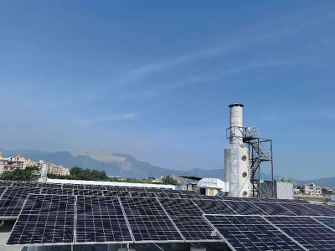OUR COMMITMENT
Aiming at being the cleanest supply base in the industry, adidas has set targets that will help limit carbon emissions aligned with the 1.5°C benchmark and contribute to a net-zero future. adidas has committed to:
- achieving climate neutrality (CO2e) across its own operations by 2025,
- reducing absolute greenhouse gas (GHG) emissions across the entire value chain by 30% by 2030, measured against 2017,
- achieving climate neutrality (CO2e) across the entire value chain by 2050.
Our emission reduction targets by 2030 have been approved by the ‘Science Based Targets initiative’ (‘SBTi’), meets SBTi’s criteria for ambitious value chain goals, meaning they are in line with current best practices.
Besides setting ambitious targets for our own, adidas also aims to have the supply network with the lowest carbon footprint in the industry. In 2022, we reached a major milestone on our path to meeting that goal, when we shared a set of clear expectations, the adidas Decarbonization Manifesto, with our strategic Tier 1 and Tier 2 suppliers. This Manifesto clearly presents how we expect our suppliers to support our decarbonization efforts, include:
- Environmental stewardship: Suppliers should set targets that get approved by the SBTi by 2024.
- Sustainable materials
- Sustainable and low-carbon Product
- Adopt renewable and clean energy sources
- Low-carbon manufacturing processes
OUR ACHIEVEMENT
With above holistic frame of decarbonization, adidas has clearly shared the goals and direction and worked with suppliers to actively execute the projects throughout supply chain. Through various and upskilling initiatives driven by our in-house team, in 2022 we have successfully helped suppliers speed up and scale up their decarbonization impact.
- Phasing out coal-fired boilers: All relevant suppliers have confirmed their commitment to replace or modify their coal-fired boilers by 2025, and 18 boilers have already been converted to non-coal fuel or decommissioned this year.
- Increasing adoption of on-site renewable energy for electricity generation: Total rooftop solar capacity across our key suppliers has doubled to 186 MWp, putting us ahead of our internal roadmap.
- Preparing suppliers to purchase electricity from off-site renewable energy sources: Our suppliers in China secured a total of 25,000 MWh of renewable energy through recently launched green power contracts.
- Continuing to increase energy efficiency: Strategic suppliers enrolled in our environmental program successfully achieved an annual improvement in energy efficiency of almost 4% compared to the baseline of 2019, leading to an accumulated improvement of almost 12% over the last three years.
- Starting SBTi progress: We have requested strategic suppliers to commitment with SBTi by 2022; Finalize baseline year & emission mapping by 2023 and SBT target approval by SBTi by 2024. By end 2022, we have 126 facilities from 35 supplier groups have committed with SBTi to set SBT target.
Suppliers’ commitment and contribution to decarbonization is crucial for our success. Their focus and perseverance will accelerate our decarbonization journey. One of our Guangdong footwear facilities has been driving their decarbonization initiatives for more than 3 years from limited knowledge on carbon emission to being a SBTi committed company. During their SBTi program process including understand reporting boundary, measure carbon emission baseline and submit SBT, they fully engaged with consultancy to gain professional support.
Moreover, this facility has invested in both on-site and off-site renewable electricity, which total estimated reduce 3,431t CO2e such as:
i) Onsite RE: Installed 1,920KWp rooftop solar which contributes around 6%-9% of total electricity consumption and estimated to reduce 1,284t CO2e per year.
Purchase offsite renewable electricity from CR Power from June 2023 which is 25% of total electricity consumption, estimated annual carbon reduction 2,147t CO2e.
ii) Purchase offsite renewable electricity from CR Power from June 2023 which is 25% of total electricity consumption, estimated annual carbon reduction 2,147t CO2e.

Besides that, facility continues to monitor and invest in energy saving measurement to increase their energy efficiency. They have set up an energy management task team, developed guidelines for energy conservation and consumption reduction, and implemented more than 100 energy saving action plans to improve efficiency, including VSD for air compressors and central control management; Rubber mixers installed with electrical savers; VSD for exhaust fans etc. The facility’s energy efficiency has improved by 33.5% compared to the 2019 baseline.
This footwear facility also regularly shares their practical experience with their upstream and downstream partners, and pledges to continue to work with all parties to implement carbon reduction targets and take every step of the low-carbon transformation.
Sustainability is a team sport!
(The above content is provided by the brand, and the authenticity of the data is the responsibility of the brand. This article has both Chinese and English versions. If there is any inconsistency, the English version shall prevail.)